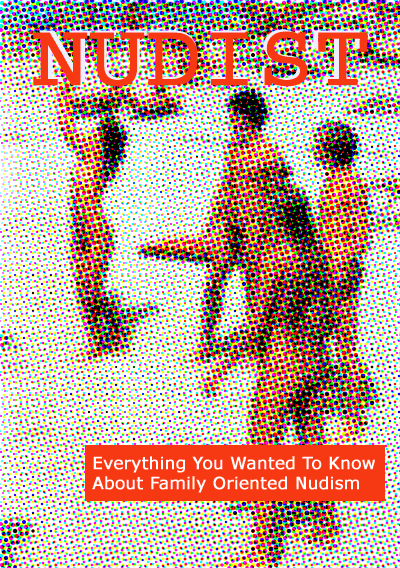In the Beginning.
For over 99 percent of known human existence our ancestors lived in communal nudity. Until loom technology emerged in Asia about 6,000 years ago, clothing wasn't an available option anywhere on the planet unless one was into fur, a bad choice for humid days.
All children grew up knowing exactly what others of their fellow species looked like. Modesty was presumably not a burning issue, and the notion that human bodies were obscene would never have been imagined. Unless taught otherwise, body acceptance was as natural as life and self acceptance.
Colonial Cover-ups.
Social nudity is an old tradition in the San Francisco Bay Area. Prior to the 18th Century invasion of their tribal villages by Western Civilization's emissaries clad in military armor and clerical robes, the earliest Californians had lived unashamedly nude in this temperate, coastal climate for over 10,000 years.
Their sad experience was a familiar story of colonialism: that is, cultural genocide, including a compulsory cover-up of naked savages in the name of civilized modesty. Instilling body shame became an essential element in the conversion and control of native peoples.
The modus operandi was systematically repeated over four centuries in the Americas, Africa, Australia, the Pacific Islands and most of the rest of the world where clothing was and is climatically superfluous. Disregarding tropical discomfort, European colonial/religious authorities made wearing clothing the most visible sign of subservience to the new order. The Hawaiian mumu was one such fashionable result.
A Culture Shifts.
Nudity was not always taboo in Europe, of course. Those prime contributors to Western Civilization, the ancient Greeks, found the nude human form both noble and artistically inspiring, competed nude in the Olympics for centuries, and sometimes even fought wars with nude combatants. Their cultural successors, the Romans, socialized nudity in their public baths, and nudity was often part of pagan ceremony and celebration throughout pre-Christian Europe.
Though early Christianity cleverly coopted key pagan holidays and myths to gain acceptance, it denounced the more flexible pagan attitudes about nudity, sexuality and the human body. Faithfully believing Jesus's Second Coming was imminent for many centuries after his crucifixion, early Christian leaders tended to be extreme ascetics who closed their doubting minds, rejected their sinful bodies and focused mostly on their spiritual hereafters. The "flesh" was seen as an evil temptation, especially if it was female.
Despite a lack of doctrinal support in the Gospels, this negative corporal attitude prevailed through various waxings and wanings for over a millennium after the Church succeeded the Roman Empire as the standard bearer of Western Civilization. If anything, the Protestants who later emerged were even more body repressive than the Catholics. Many of Europe's most radical religious sects were forced to emigrate to America, where their legacy lingers.
Old-fashioned beach wearThe "Body Taboo" peaked in influence and absurdity in the Victorian Age when even bare piano legs were considered risque in "polite society". By the end of the 19th Century European colonialism was winding down for lack of new, unplundered targets, and most of the accessible naked heathen still left alive had been clad to more modest standards.
At last civilized people seemed safe from the presumed moral danger of seeing a nude human body, including even one's own. Undressing in the dark was the norm, bathing was not especially encouraged, and s-e-x, also performed in the dark and never discussed, was only for procreation, never recreation. (No woman of good moral character would admit erotic pleasure from the act of love lest she be thought promiscuous.)
Nudity Returns.
Early in the 20th Century social nudity began its first European comeback since Rome was sacked. An international body acceptance movement emerged to propose nudity in nature as a humanizing antidote to the repressive extremes of both puritanical Victorianism and urban industrialism.
Known as "Free Body Culture" in Germany, "Naturism" in most of Europe, and eventually "Nudism" as it reached American shores in the third decade, the movement's secular, idealistic philosophy included non-sexual social nudity, outdoor exercise, a healthy, non-alcoholic, usually vegetarian diet, and a spiritual bond with nature. Though it was not a religion and neither opposed nor promoted any religion, it provided a convenient symbolic target for many ambitious guardians of public morality, especially in the U.S., where nudity seemed indistinguishable from sexuality in the public mind.
Interrupted only by wars, the body acceptance movement spread very rapidly, especially in Europe, where it eventually devolved from the utopian to the mostly recreational as social nudity became more popular. A BBC documentary in the 1980's estimated that over 50 million Europeans enjoyed naturist holidays.
American tourists are often astonished by European body freedom. In less than a century Europe transformed from total suppression of nudity to a situation where many of the most popular beaches are clothing-optional, as are sections of certain urban parks, spas and resorts.
Frontal nudity, censored in America, is commonly shown on European television, while violence is much less often depicted than in the U.S. Nude destination resorts flourish in the warmest climates, and one of the largest holiday centers in the world, France's Cap d'Agde, is all nude, serving a capacity of over 40,000 in season.
America's Slower Transition.
Body acceptance developments in The New World have lagged behind those in Europe. Private nudist clubs, parks and campgrounds first emerged in the 1930's facing nervous media ridicule, censorship and The Depression. Neither World War II nor the regressive 1950's gave the American movement much encouragement after its inauspicious debut, and early growth was glacial.
After finally winning the legal right to publish and mail innocuous nude photos in the late 1950's, nudist publications were swamped in the marketplace in the 1960's by an explosive growth of unrelated pornography with much more erotic images. Their magazines' commercial failure left the mostly family-oriented nudist clubs with few outreach channels besides word-of-mouth by an often secretive membership, and thus they generated few resources for growth and development.
Beach nudity, usually at remote or hard-to-reach sites, grew in popularity beginning in the 1960's. Black's Beach, a cliff-protected, clothing-optional mecca for nude sand-and-surf lovers near San Diego, has attracted over 10,000 participants on seasonal holidays during the following decades.
The Sexual Revolution and the addition of backyard swimming pools and hot tubs made discrete private nudity more sociable and normal through the 1970's. Polls in the 1980's found that although less than 20% of Americans had by then experienced coed social nudity, over 70% felt that designating clothing-optional beaches was an acceptable concept.
Nude Choices in the 1990's.
While only a scattered few clothing-optional beaches are legally recognized in the U.S., guidebooks by The Naturist Society, and others list hundreds of beaches and public recreation areas where social nudity is unofficially accepted as a matter of usage. The annual nude beach survey by the Bay Guardian usually catalogs almost a hundred such sites just in Northern California, perhaps the most body-positive region in the West.
American Association for Nude Recreation, the largest and oldest of several nude advocacy organizations, includes over 200 U.S. and Canadian affiliated clubs with a total membership of about 50,000. The most successful AANR clubs, attracting up to 5,000 members, are located in central Florida.
The founding in the mid-1980's of TANR, the Trade Association for Nude Recreation, reflected the emergence of nude recreation as a fledgling niche of this hemisphere's hospitality industry. Though it may yet lack depth, it offers surprising breadth. Those seeking a relaxing clothes-free getaway or vacation in the 1990's can choose among full-service destination resorts, clubs, cruises, campgrounds, parks, hot springs, spas and bed-and-breakfast inns across North America and the Caribbean.
Several large Jamaican resorts, taking a hint from Club Med, have established "nude" and "prude" beach sections. The adoption of a clothing-optional beach has helped revive the fortunes of a recently renovated strip of Miami Beach hotels. Clusters of nude recreation facilities are beginning to emerge in tourist areas around Tampa, Florida, and Palm Springs, California.
The signs are encouraging that Americans are finally becoming more accepting of social nudity. The constraining issues tend to be more about personal body image than lingering cultural prohibitions. If Europe is the precursor, body acceptance and nude recreation still have a long way to grow in the U.S.

How To Talk To A Non-Nudist About The Nudist Lifestyle FAQs about a Lupin Vacation A Male Tribute to Lupin Naturist Club Women Lupin, Nudity, And Sexuality Serendipity Nudist Resort Who Wins in Nude Recreation? Pondering the Penis What Others Say About Nudism The Lupin Guide to Nude Recreation Newd Life
E-mail: office@a-nudist.com
(718) 552-6151/22
Public Office - New York City, USA © 1997-2021

New to Social Nudity?
Social Nudity: An Antidote to the "Beauty Myth"
Kids and Nudism
Nude Humor A Brief History of Social Nudity
Preventing Sexual Harassment at Lupin Naturist Club
Guidelines and Rules of Conduct for Serendipity Park
First-Timer's Guide Gay Naturist History
Serendipity is The First
Nudism F.A.Q.
Christian Naturists